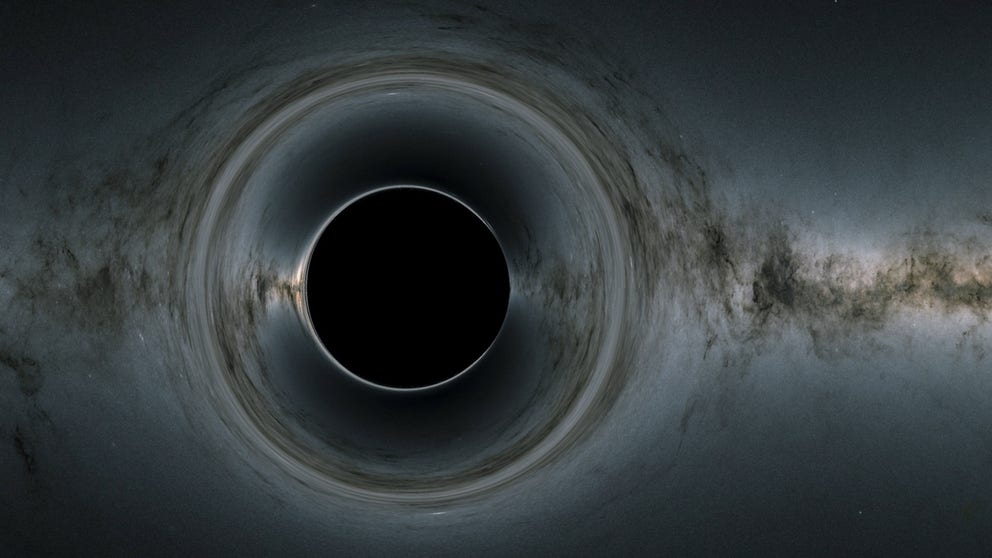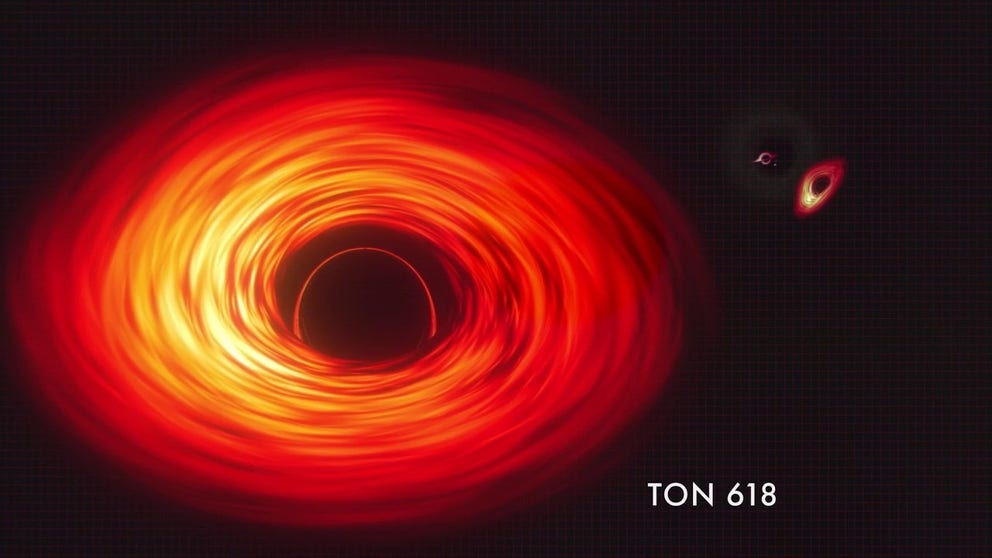Supermassive black holes: Just how big are they?
How big is a supermassive black hole? Hint: It makes Earth look tiny. NASA released a new animation that puts Earth and the supersized black holes into perspective.
What is a black hole? Explaining the universe's most mysterious cosmic object
Much studied but not fully understood, black holes are among the most mysterious cosmic objects in our universe.
Do you know how big a supermassive black hole is? It's so big… that the fastest moving thing in our universe, light traveling at 670 million mph, would take weeks to cross its shadow.
That is the case for the black hole known as TON 618 – a very distant black hole that NASA called "behemoth." Its mass is more than 60 billion suns, and any light from it takes more than 10 billion years to reach the Earth.
HUBBLE SPACE TELESCOPE USED TO WATCH BLACK HOLE EAT A STAR
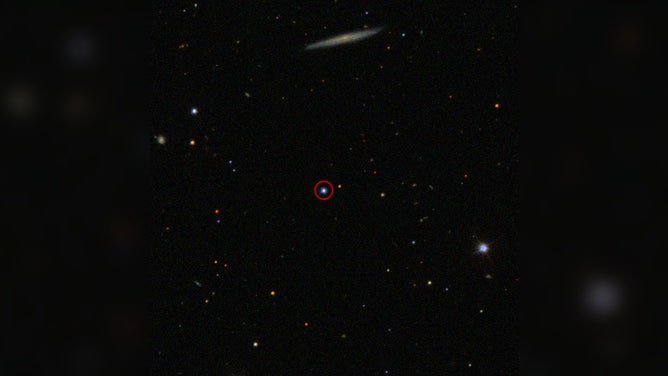
Light from the supermassive black hole known as TON 618 (circled) takes more than 10 billion years to reach us.
(SDSS / NASA)
WATCH OUT FOR THESE ASTRONOMICAL EVENTS IN 2023
Astronomers use our sun's mass as a relative measure for huge things in the universe, such as black holes. According to NASA, the mass of a black hole is usually called a "solar mass." One solar mass is defined as the mass of our sun.
Supersized black holes
This is the universe’s way of supersizing. NASA produced a clip showing the relative sizes of the sun, planets and 10 supermassive black holes. Supermassive black holes reside in the center of most large galaxies, according to NASA, and range from 100,000 solar mass to billions.
WHAT IS A BLACK HOLE? HERE'S WHY THESE ENIGMAS OF SPACE DON'T SUCK
How big are supermassive black holes compared to Earth?
All monster black holes are not equal. Watch this video to see how they compare to each other and to our solar system. The black holes shown, which range from 100,000 to more than 60 billion times our Sun’s mass, are scaled according to the sizes of their shadows – a circular zone about twice the size of their event horizons. Only one of these colossal objects resides in our own galaxy, and it lies 26,000 light-years away. Smaller black holes are shown in bluish colors because their gas is expected to be hotter than that orbiting larger ones. Scientists think all of these objects shine most intensely in ultraviolet light.
PASS THE BIB: WATCH AS STUDY SIMULATES BLACK HOLES EATING GALAXY STARS LIKE MESSY TODDLERS
"Direct measurements, many made with the help of the Hubble Space Telescope, confirm the presence of more than 100 supermassive black holes," said Jeremy Schnittman, a theorist at NASA’s Goddard Space Flight Center, in a statement. "How do they get so big? When galaxies collide, their central black holes eventually may merge together too."
A black hole is a vast mass in a very tiny volume. The black hole's name comes from the area just beneath the surface known as the event horizon, which traps light and anything else in its path forever with the structure’s intense gravity. This vast blackness contains all the matter of the black hole.
IMAGES SHOW GIANT BLACK HOLES ON A COSMIC COLLISION COURSE IN DWARF GALAXIES FAR, FAR AWAY
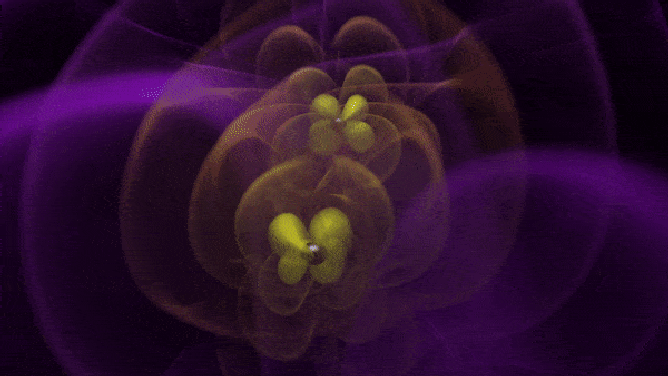
This visualization shows gravitational waves emitted by two black holes (black spheres) of nearly equal mass as they spiral together and merge. Yellow structures near the black holes illustrate the strong curvature of space-time in the region. Orange ripples represent distortions of space-time caused by the rapidly orbiting masses. These distortions spread out and weaken, ultimately becoming gravitational waves (purple). As the two black holes near each other, they merge into a single black hole that settles into its "ringdown" phase, where the final gravitational waves are emitted.
(NASA/Bernard J. Kelly (Goddard and Univ. of Maryland Baltimore County), Chris Henze (Ames) and Tim Sandstrom (CSC Government Solutions LLC) / NASA)
Images show the dark "shadow" surrounded by a bright ring of hot orbiting gas, according to NASA. The shadow is about twice the size of the black hole’s event horizon.
The smallest supermassive black hole in the animation is 1601+3113, a dwarf galaxy. The hole is the mass of 100,000 suns, but the matter is so tightly compressed that the black hole’s shadow is smaller than the sun.
LISTEN TO THE HAUNTING SOUNDS OF A BLACK HOLE

This is the first image of Sagittarius A*, the supermassive black hole at the center of our galaxy. It was captured by the Event Horizon Telescope (EHT), an array which linked together eight existing radio observatories across the planet to form a single "Earth-sized" virtual telescope.
(Event Horizon Telescope Collaboration / NASA)
Sagittarius A* (pronounced ay star) is the Milky Way Galaxy’s supermassive black hole. With a mass of 4.3 million suns, it’s a virtual lightweight compared to TON 618. Earth sits about 26,000 light-years away.
NASA says a few million Earths would fit in the space of Sgr A*. The black hole's diameter is about half the orbit of Mercury, the closest planet to the sun.
Put supermassive in perspective
For comparison, the sun sits just 0.00001581 light-years away from Earth or 8.2 light minutes. That means the sun’s light takes over 8 minutes to reach the surface of the Earth. One light year is about 5.88 trillion miles.
'BIZARRE GAME OF GALACTIC BILLIARDS' CREATES RUNAWAY BLACK HOLE LEAVING TRAIL OF STARS IN ITS WAKE
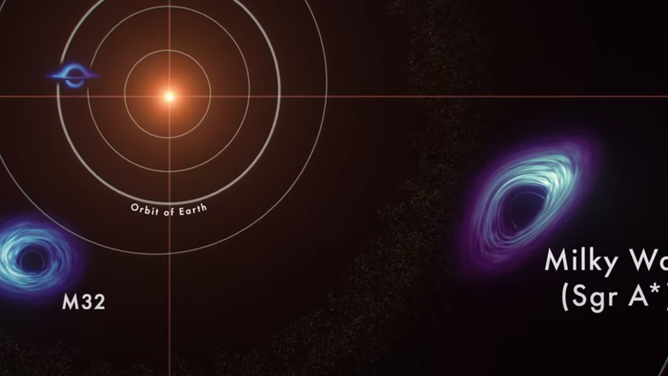
This frame from NASA’s new animation compares the sizes of three supermassive black holes in relation to planetary orbits in our solar system. At top left, unlabeled, is the black hole at the center of the Circinus galaxy. Below it lies the giant black hole in galaxy M32. And at right is the more massive black hole at the heart of our own Milky Way galaxy.
(NASA's Goddard Space Flight Center Conceptual Image Lab / NASA)
Earth is minuscule compared to the supermassive black holes. It would take 109 Earths to span the diameter of the sun, according to Space.com. The sun is more than 300,000 times heavier than Earth, according to the National Center for Atmospheric Research.
More research on the horizon
NASA is working with the European Space Agency to develop the Laser Interferometer Space Antenna or LISA mission, expected to launch in the next decade. LISA is made up of 3 spacecraft that shoot laser beams at each other, millions of miles away, to detect gravitational waves of merging black holes.
